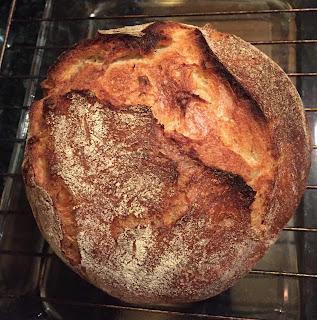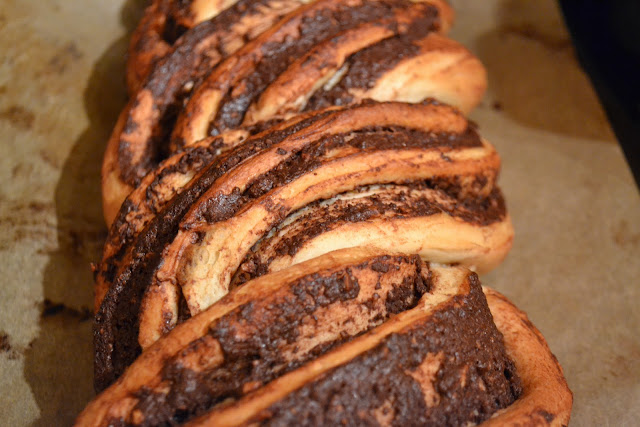Sticking With It
This weekend, I made my second recipe from Ken Forkish's Flour, Water, Salt, Yeast: The Fundamentals of Bread and Pizza. (A writeup about the first attempt will come soon. It was a whirlwind.)
What both of these bakes have taught me is that you can really mess up some things when it comes to the recipe, but the bread will still taste good—when you're only working with four ingredients, at least. Forkish is clearly striving for perfection, and his particular vision of perfection. But for a layperson like me, I'm extra pleased when I get not just edible but tasty bread in the end.
For the first bake, I used the simple Saturday White Bread recipe. The second time, I used that recipe again but went with his suggested variation—instead of 1000 g of King Arthur's AP flour, I used 900 g AP and 100 g King Arthur's whole wheat. It's supposed to give it an earthier flavor.
I followed the recipe exactly. Because of mistakes that I'd made the first time around with the yeast and too much kneading, I was very careful about sticking to the book. I even put our house thermometer in the kitchen and kept opening and closing windows to make sure the ambient temperature was right and the final dough ended up around 78 degrees.
But the bread just didn't rise. Despite all my efforts, it remained a kinda sad little lump.
Here's the way the bread started (sorry for the iPhone photos; I was too focused on the recipe to take shots with the real camera):
After 10 minutes, as instructed, I gave it one fold. Then, after about an hour, I gave it another fold. More gas had clearly built up in the dough (you can see that in the lumps in these photos), but not as much as last time I made this. Still, everything was largely on track.
The next step was about four hours of waiting. After five hours total of bulk fermentation, the dough ball was supposed to have tripled in size. Mine had not even doubled. Instead, it had just spread out and become floppier.
Thinking that my thermometer was off, I cranked up the room heat and gave the bread another hour or so. Didn't work. Here's where Little Doughy and I ended up (terrible photo):
After five hours of bulk fermentation last time, the dough was like the Blob. Jiggling and bubbling and threatening to escape its living quarters.
I was going to throw in the towel but tried baking it anyway. And boy am I glad I did. Behold:
In the end, I think there was an issue with the yeast. I know that adding whole wheat flour will make a tighter and slightly drier dough if I don't increase the water content, and that the air is drier now than the first time I made this bread. But I don't think that was all of the problem. That yeast mistake I said I made the first time around tipped me off.
Forkish says that you don't need to start your yeast in water/sugar before putting it in the dough. You're supposed to sprinkle it right on top of the dough ball. The dough has a high-enough proportion of water and the mixing process is vigorous enough to get the yeast fired up on its own.
I don't think that advice holds for the Red Star brand active dry yeast. I think that yeast needs a bit more help—which is what I gave it during my first try. I started the yeast in water and sugar, and then added that mixture to the dough. This led to an overly wet dough and required adding more flour and increasing the kneading. This resulted in a too-dense final product. But the bulk fermentation worked perfectly.
Next time I make this recipe, I'm going to try increasing the temperature of the water I add to the dough, so the yeast that I sprinkle on top has more warmth. I might also add a bit more water to the mix to compensate for the whole wheat flour.
In the end, though, the bread was delicious. The lackluster fermentation created a dough that was not as light and airy as Forkish wants. But it was moist and very tasty.
What both of these bakes have taught me is that you can really mess up some things when it comes to the recipe, but the bread will still taste good—when you're only working with four ingredients, at least. Forkish is clearly striving for perfection, and his particular vision of perfection. But for a layperson like me, I'm extra pleased when I get not just edible but tasty bread in the end.
For the first bake, I used the simple Saturday White Bread recipe. The second time, I used that recipe again but went with his suggested variation—instead of 1000 g of King Arthur's AP flour, I used 900 g AP and 100 g King Arthur's whole wheat. It's supposed to give it an earthier flavor.
I followed the recipe exactly. Because of mistakes that I'd made the first time around with the yeast and too much kneading, I was very careful about sticking to the book. I even put our house thermometer in the kitchen and kept opening and closing windows to make sure the ambient temperature was right and the final dough ended up around 78 degrees.
But the bread just didn't rise. Despite all my efforts, it remained a kinda sad little lump.
Here's the way the bread started (sorry for the iPhone photos; I was too focused on the recipe to take shots with the real camera):
 |
| Little Doughy begins bulk fermentation. |
After 10 minutes, as instructed, I gave it one fold. Then, after about an hour, I gave it another fold. More gas had clearly built up in the dough (you can see that in the lumps in these photos), but not as much as last time I made this. Still, everything was largely on track.
 |
| After the required two folds. |
The next step was about four hours of waiting. After five hours total of bulk fermentation, the dough ball was supposed to have tripled in size. Mine had not even doubled. Instead, it had just spread out and become floppier.
Thinking that my thermometer was off, I cranked up the room heat and gave the bread another hour or so. Didn't work. Here's where Little Doughy and I ended up (terrible photo):
 |
| Cue sad trombone. Rise fail. |
After five hours of bulk fermentation last time, the dough was like the Blob. Jiggling and bubbling and threatening to escape its living quarters.
I was going to throw in the towel but tried baking it anyway. And boy am I glad I did. Behold:
 |
| It was gorgeous. And really tasty. |
In the end, I think there was an issue with the yeast. I know that adding whole wheat flour will make a tighter and slightly drier dough if I don't increase the water content, and that the air is drier now than the first time I made this bread. But I don't think that was all of the problem. That yeast mistake I said I made the first time around tipped me off.
Forkish says that you don't need to start your yeast in water/sugar before putting it in the dough. You're supposed to sprinkle it right on top of the dough ball. The dough has a high-enough proportion of water and the mixing process is vigorous enough to get the yeast fired up on its own.
I don't think that advice holds for the Red Star brand active dry yeast. I think that yeast needs a bit more help—which is what I gave it during my first try. I started the yeast in water and sugar, and then added that mixture to the dough. This led to an overly wet dough and required adding more flour and increasing the kneading. This resulted in a too-dense final product. But the bulk fermentation worked perfectly.
Next time I make this recipe, I'm going to try increasing the temperature of the water I add to the dough, so the yeast that I sprinkle on top has more warmth. I might also add a bit more water to the mix to compensate for the whole wheat flour.
In the end, though, the bread was delicious. The lackluster fermentation created a dough that was not as light and airy as Forkish wants. But it was moist and very tasty.


Comments
Post a Comment